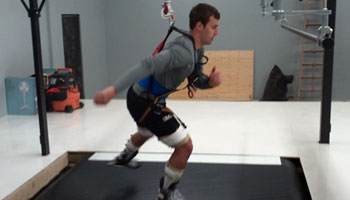An ongoing debate in the hockey world concerns the use of treadmill skating as a development tool. Some contend that skating on a treadmill may adversely alter a player’s stride, while others applaud its usefulness. While the skating treadmill should never completely replace on-ice skating (obviously), it can be used in conjunction with on-ice training as a tool to help improve your skills as a hockey player.
Hockey is a fast-paced game rarely played out in straight lines. Skills such as pivoting, turning and accelerating must be part of every player’s skill repertoire. However, if the basic skating stride is not mastered, these more complex movements will be flawed, and you will not be able to move around the ice as quickly and efficiently as you need to.
Nothing will ever replace on-ice hockey training, but treadmill skating offers players an excellent opportunity to refine their technique and improve their conditioning. However, I can’t endorse treadmill skating on an incline. This doesn’t make sense, because you have to skate more like you are running and with a narrower angle of push. Also, you never skate uphill in a game.

Jordan Eberle of the Edmonton Oilers on a skating treadmill
So, if you have access to a skating treadmill, focus on refining your stride technique. (For a detailed breakdown on stride mechanics, read How to Increase Skating Speed for Hockey, Part 2.) Most likely, a mirror will sit in front of you and a coach will be present, so you can get instant feedback on what you are doing well and what needs improvement. Also, you can work on your skating technique while stickhandling, an often-overlooked skill. If you can’t skate fast when handling a stick, how will you ever beat a defender?
The utility and effectiveness of skating treadmills will continue to be debated, but since many communities lack ice rinks, such a tool seems to me a viable option for players to continue their development.
Photo: extraedgeacademy.com
Adam Redmond, CSCS, owns RedTech Innovations, a software development company that analyzes the stride of hockey players. He also trains athletes at Crash Conditioning, and he has worked for more than a decade with Steve Serdachny, the Edmonton Oilers’ skating and skills coach. Redmond played hockey for the University of Calgary Dinos, where he was an Academic All-Canadian.
RECOMMENDED FOR YOU
MOST POPULAR
An ongoing debate in the hockey world concerns the use of treadmill skating as a development tool. Some contend that skating on a treadmill may adversely alter a player’s stride, while others applaud its usefulness. While the skating treadmill should never completely replace on-ice skating (obviously), it can be used in conjunction with on-ice training as a tool to help improve your skills as a hockey player.
Hockey is a fast-paced game rarely played out in straight lines. Skills such as pivoting, turning and accelerating must be part of every player’s skill repertoire. However, if the basic skating stride is not mastered, these more complex movements will be flawed, and you will not be able to move around the ice as quickly and efficiently as you need to.
Nothing will ever replace on-ice hockey training, but treadmill skating offers players an excellent opportunity to refine their technique and improve their conditioning. However, I can’t endorse treadmill skating on an incline. This doesn’t make sense, because you have to skate more like you are running and with a narrower angle of push. Also, you never skate uphill in a game.

Jordan Eberle of the Edmonton Oilers on a skating treadmill
So, if you have access to a skating treadmill, focus on refining your stride technique. (For a detailed breakdown on stride mechanics, read How to Increase Skating Speed for Hockey, Part 2.) Most likely, a mirror will sit in front of you and a coach will be present, so you can get instant feedback on what you are doing well and what needs improvement. Also, you can work on your skating technique while stickhandling, an often-overlooked skill. If you can’t skate fast when handling a stick, how will you ever beat a defender?
The utility and effectiveness of skating treadmills will continue to be debated, but since many communities lack ice rinks, such a tool seems to me a viable option for players to continue their development.
Photo: extraedgeacademy.com
Adam Redmond, CSCS, owns RedTech Innovations, a software development company that analyzes the stride of hockey players. He also trains athletes at Crash Conditioning, and he has worked for more than a decade with Steve Serdachny, the Edmonton Oilers’ skating and skills coach. Redmond played hockey for the University of Calgary Dinos, where he was an Academic All-Canadian.











